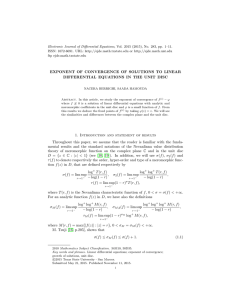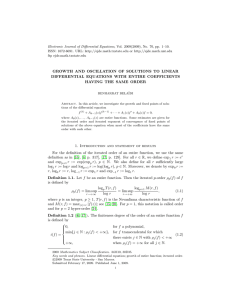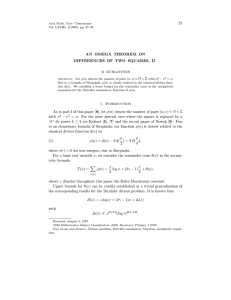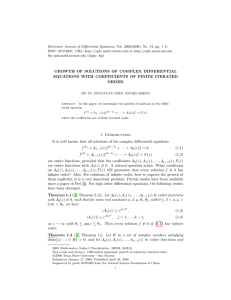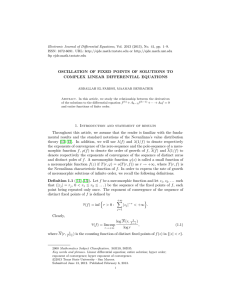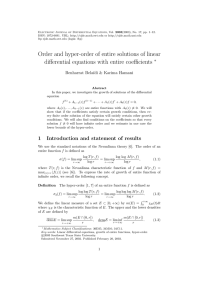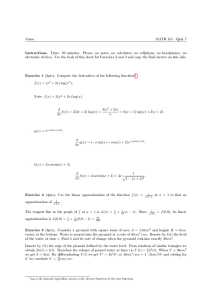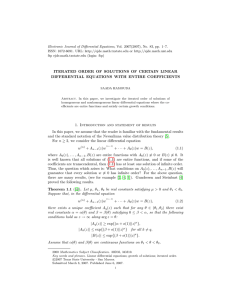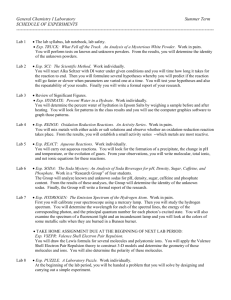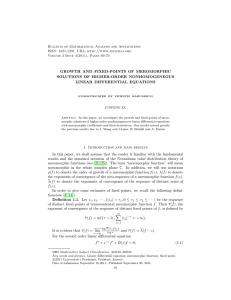Acta Mathematica Academiae Paedagogicae Ny´ıregyh´ aziensis 32
advertisement
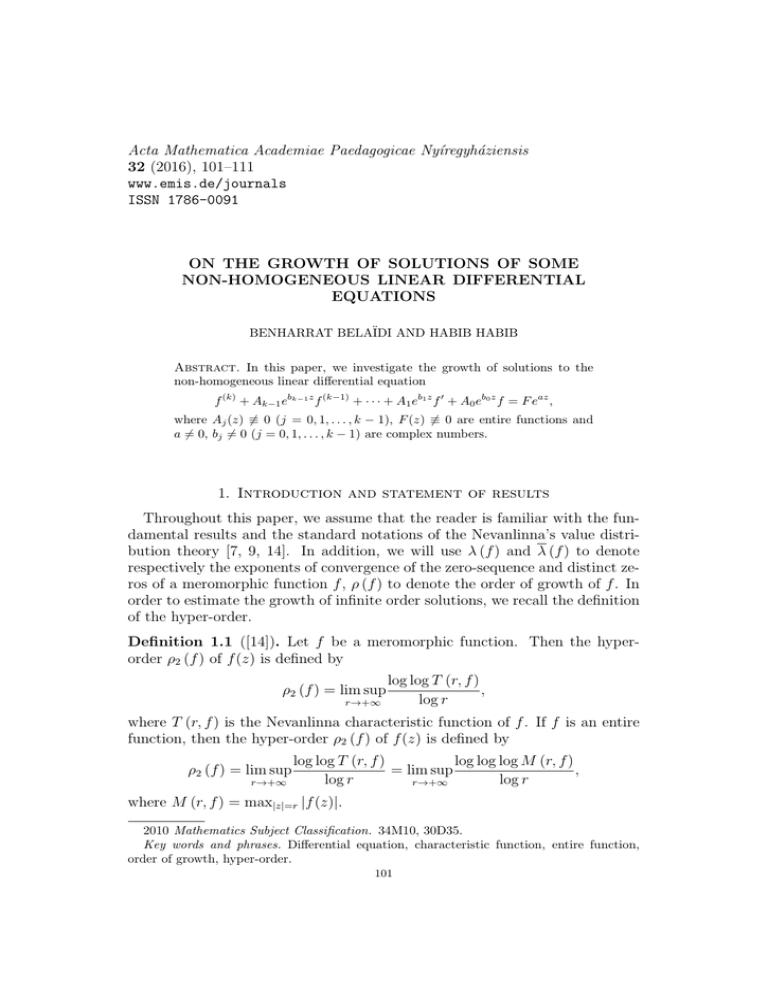
Acta Mathematica Academiae Paedagogicae Nyı́regyháziensis
32 (2016), 101–111
www.emis.de/journals
ISSN 1786-0091
ON THE GROWTH OF SOLUTIONS OF SOME
NON-HOMOGENEOUS LINEAR DIFFERENTIAL
EQUATIONS
BENHARRAT BELAÏDI AND HABIB HABIB
Abstract. In this paper, we investigate the growth of solutions to the
non-homogeneous linear differential equation
f (k) + Ak−1 ebk−1 z f (k−1) + · · · + A1 eb1 z f 0 + A0 eb0 z f = F eaz ,
where Aj (z) 6≡ 0 (j = 0, 1, . . . , k − 1), F (z) 6≡ 0 are entire functions and
a 6= 0, bj =
6 0 (j = 0, 1, . . . , k − 1) are complex numbers.
1. Introduction and statement of results
Throughout this paper, we assume that the reader is familiar with the fundamental results and the standard notations of the Nevanlinna’s value distribution theory [7, 9, 14]. In addition, we will use λ (f ) and λ (f ) to denote
respectively the exponents of convergence of the zero-sequence and distinct zeros of a meromorphic function f , ρ (f ) to denote the order of growth of f . In
order to estimate the growth of infinite order solutions, we recall the definition
of the hyper-order.
Definition 1.1 ([14]). Let f be a meromorphic function. Then the hyperorder ρ2 (f ) of f (z) is defined by
ρ2 (f ) = lim sup
r→+∞
log log T (r, f )
,
log r
where T (r, f ) is the Nevanlinna characteristic function of f . If f is an entire
function, then the hyper-order ρ2 (f ) of f (z) is defined by
ρ2 (f ) = lim sup
r→+∞
log log T (r, f )
log log log M (r, f )
= lim sup
,
log r
log r
r→+∞
where M (r, f ) = max|z|=r |f (z)|.
2010 Mathematics Subject Classification. 34M10, 30D35.
Key words and phrases. Differential equation, characteristic function, entire function,
order of growth, hyper-order.
101
102
BENHARRAT BELAÏDI AND HABIB HABIB
Definition 1.2. [14] Let f be a meromorphic function. Then the hyperexponent of convergence of the sequence of zeros of f (z) is defined by
log log N r, f1
λ2 (f ) = lim sup
,
log r
r→+∞
where N r, f1 is the integrated counting function of zeros of f (z) in {z : |z| ≤ r}.
Similarly, the hyper-exponent of convergence of the sequence of distinct zeros
of f (z) is defined by
log log N r, f1
λ2 (f ) = lim sup
,
log r
r→+∞
where N r, f1 is the integrated counting function of distinct zeros of f (z) in
{z : |z| ≤ r}.
The complex oscillatory problems of the non-homogeneous linear differential equations are a very important aspect of the complex oscillation theory of
differential equations, which has a large number of potential applications. For
growth estimates of solutions of a non-homogeneous linear differential equation, in general there exist exceptional solutions that are not easy to discuss,
see [9, Chapter 8].
In [11] Wang and Laine investigated the growth of solutions of some second
order nonhomogeneous linear differential equation and obtained.
Theorem A ([11]). Let Aj (z) 6≡ 0 (j = 0, 1) and F (z) be entire functions
with max{ρ (Aj ) (j = 0, 1), ρ (F )} < 1, and let a, b be complex constants that
satisfy ab 6= 0 and a 6= b. Then every nontrivial solution f of the differential
equation
f 00 + A1 (z)eaz f 0 + A0 (z) ebz f = F,
is of infinite order.
Remark 1.1. The result of Theorem A was also obtained by the author and El
Farissi in [2] by another proof.
Later in [12] Wang and Laine extend the result of Theorem A to higher
order non-homogeneous linear differential as follows.
Theorem B ([12]). Suppose that Aj (z) = hj (z)ePj (z) (j = 0, 1, . . . , k − 1)
where Pj (z) = ajn z n + · · · + aj0 are polynomials with degree n ≥ 1, hj (z) 6≡ 0
(j = 0, 1, . . . , k−1) are entire functions of order less than n, and that H(z) 6≡ 0
is an entire function of order less than n. If ajn (j = 0, 1, . . . , k−1) are distinct
complex numbers, then every solution f of the differential equation
f (k) + Ak−1 (z)f (k−1) + · · · + A1 (z)f 0 + A0 (z)f = H(z)
is of infinite order.
ON THE GROWTH OF SOLUTIONS
103
Recently, the authors investigated the growth of some nonhomogeneous
higher order linear differential equations and obtained the following result.
Theorem C ([3]). Let k ≥ 2 be an integer, Ij ⊂ N (j = 0, 1, . . . , k − 1)
k−1
be finite sets such that Ij ∩ Im = ∅ (j =
6 m) and I = ∪ Ij . Suppose that
j=0
P
Pi (z)
Bj =
Ai e
(j = 0, 1, . . . , k − 1), where Ai (z) 6≡ 0 (i ∈ I) are entire
i∈Ij
functions with max{ρ (Ai ) , i ∈ I} < n, Pi (z) = ain z n + · · · + ai1 z + ai0 (i ∈ I)
are polynomials with degree n ≥ 1 and that F (z) 6≡ 0 is an entire function with
ρ (F ) < n. If ain (i ∈ I) are distinct complex numbers, then every solution f
of the differential equation
f (k) + Bk−1 f (k−1) + · · · + Bl f (l) + · · · + B1 f 0 + B0 f = F
satisfies ρ (f ) = +∞.
The main purpose of this paper is to investigate the order and the hyperorder of growth to some higher order linear differential equations. In fact we
will prove the following results.
Suppose that
I = {0, 1, 2, . . . , k − 1} ,
I1 = {i ∈ I : ci > 1} 6= ∅,
I2 = {i ∈ I : 0 < ci < 1} 6= ∅,
I3 = {i ∈ I : ci < 0} 6= ∅,
I4 = {i ∈ I : ci = 1} 6= ∅,
where I1 ∪ I2 ∪ I3 ∪ I4 = I and ci (i ∈ I) are real numbers.
Theorem 1.1. Let Aj (z) 6≡ 0 (j ∈ I), F (z) 6≡ 0 be entire functions with
max {ρ (Aj ) (j ∈ I) , ρ (F )} < 1, a 6= 0 and bi 6= 0 (i ∈ I) be complex numbers
such that bi = ci a (i ∈ I). Suppose that there is one s ∈ I1 such that cs > cj
for all j ∈ I1 \ {s}, suppose that there is one l ∈ I3 such that cl < cj for all
j ∈ I3 \ {l}, and suppose that c0 6= 1 and c0 6= cj for all j ∈ I \ {0}. Then
every solution f of the differential equation
(1.1)
f (k) + Ak−1 ebk−1 z f (k−1) + · · · + A1 eb1 z f 0 + A0 eb0 z f = F eaz
has infinite order and the hyper-order satisfies ρ2 (f ) ≤ 1.
Theorem 1.2. Under the hypotheses of Theorem 1.1, suppose further that
ϕ(z) 6≡ 0 is an entire function with finite order. Then every solution f of
(1.1) satisfies
λ (f ) = λ (f ) = λ (f − ϕ) = λ (f − ϕ) = ρ (f ) = ∞
and
λ2 (f ) = λ2 (f ) = λ2 (f − ϕ) = λ2 (f − ϕ) = ρ2 (f ) ≤ 1.
104
BENHARRAT BELAÏDI AND HABIB HABIB
2. Auxiliary lemmas
Lemma 2.1 ([13]). Suppose that f1 (z), f2 (z), . . . , fn (z) (n ≥ 2) are meromorphic functions and g1 (z), g2 (z), . . . , gn (z) are entire functions satisfying the
following conditions:
n
P
(i)
fj (z) egj (z) ≡ fn+1 .
j=1
(ii) If 1 ≤ j ≤ n + 1 and 1 ≤ k ≤ n, then the order of fj is less than the
order of egk (z) . If n ≥ 2, 1 ≤ j ≤ n + 1 and 1 ≤ h < k ≤ n, then the
order of fj is less than the order of egh −gk .
Then fj (z) ≡ 0 (j = 1, 2, . . . , n + 1).
Lemma 2.2 ([4]). Suppose that P (z) = (α + iβ) z n + · · · (α, β are real numbers, |α| + |β| 6= 0) is a polynomial with degree n ≥ 1, that A(z) 6≡ 0 is an
entire function with ρ (A) < n. Set g(z) = A(z)eP (z) , z = reiθ , δ (P, θ) =
α cos nθ − β sin nθ. Then for any given ε > 0, there is a set E1 ⊂ [0, 2π) that
has linear measure zero, such that for any θ ∈ [0, 2π) (E1 ∪ E2 ), there is
R > 0, such that for |z| = r > R, we have
(i) If δ (P, θ) > 0, then
exp {(1 − ε) δ (P, θ) rn } ≤ g reiθ ≤ exp {(1 + ε) δ (P, θ) rn } .
(ii) If δ (P, θ) < 0, then
exp {(1 + ε) δ (P, θ) rn } ≤ g reiθ ≤ exp {(1 − ε) δ (P, θ) rn } ,
where E2 = {θ ∈ [0, 2π) : δ (P, θ) = 0} is a finite set.
Lemma 2.3 ([6]). Let f be a transcendental meromorphic function of finite
order ρ. Let ε > 0 be a constant, k and j be integers satisfying k > j ≥ 0.
Then the following two statements hold:
(i) There exists a set E3 ⊂ (1, +∞) which has finite logarithmic measure,
such that for all z satisfying |z| ∈
/ E3 ∪ [0, 1], we have
(k) f (z) (k−j)(ρ−1+ε)
(2.1)
.
f (j) (z) ≤ |z|
(ii) There exists a set E4 ⊂ [0, 2π) which has linear measure zero, such that
if θ ∈ [0, 2π) \ E4 , then there is a constant R = R (θ) > 0 such that (2.1)
holds for all z satisfying arg z = θ and |z| ≥ R.
Lemma 2.4 ([12]). Let f (z) be an entire function and suppose that
log+ f (k) (z)
G(z) :=
|z|ρ
is unbounded on some ray arg z = θ with constant ρ > 0. Then there exists
an infinite sequence of points zn = rn eiθ (n = 1, 2, . . .), where rn → +∞, such
ON THE GROWTH OF SOLUTIONS
105
that G (zn ) → ∞ and
(j)
f (zn ) 1
k−j
f (k) (zn ) ≤ (k − j)! (1 + o (1)) rn , j = 0, 1, . . . , k − 1
as n → +∞.
Lemma 2.5 ([12]). Let f (z) be an entire function with ρ (f ) = ρ < +∞.
Suppose that there
exists
a set E5 ⊂ [0, 2π) which has linear measure zero,
such that log+ f reiθ ≤ M rσ for any ray arg z = θ ∈ [0, 2π) \ E5 , where M
is a positive constant depending on θ, while σ is a positive constant independent
of θ. Then ρ (f ) ≤ σ.
Lemma 2.6 ([1, 5]). Let A0 , A1 , . . . , Ak−1 , F 6≡ 0 be finite order meromorphic
functions.
(i) If f is a meromorphic solution of the equation
(2.2)
f (k) + Ak−1 f (k−1) + · · · + A1 f 0 + A0 f = F
with ρ (f ) = +∞, then f satisfies
λ (f ) = λ (f ) = ρ (f ) = +∞.
(ii) If f is a meromorphic solution of equation (2.2) with ρ (f ) = +∞ and
ρ2 (f ) = ρ, then
λ (f ) = λ (f ) = ρ (f ) = +∞, λ2 (f ) = λ2 (f ) = ρ2 (f ) = ρ.
By using Wiman–Valiron theory [8], we easily obtain the following result
which we omit the proof.
Lemma 2.7. Let B0 (z), . . . , Bk−1 (z), H(z) be entire functions of finite order.
If f is a solution of the equation
f (k) + Bk−1 (z)f (k−1) + · · · + B1 (z)f 0 + B0 (z)f = H,
then ρ2 (f ) ≤ max {ρ (B0 ) , . . . , ρ (Bk−1 ) , ρ (H)}.
3. Proof of Theorem 1.1
Since bi = ci a (i ∈ I), then by (1.1) we get
X
X
(3.1) e−az f (k) +
Ai e(ci −1)az f (i) +
Ai e(ci −1)az f (i)
i∈I1
i∈I2
+
X
Ai e(ci −1)az f (i) +
i∈I3
X
Ai f (i) = F.
i∈I4
First we prove that every solution f of (1.1) satisfies ρ (f ) ≥ 1. We assume
that ρ (f ) < 1. It is clear that f 6≡ 0. We can rewrite (3.1) in the form
X
X
(3.2)
f (k) e−az +
Bi e(ci −1)az + A0 f e(c0 −1)az = F −
Ai f (i) ,
i∈Γ
i∈I4
106
BENHARRAT BELAÏDI AND HABIB HABIB
where Γ ⊆ I \ (I4 ∪ {0}) such that (ci − 1)a (i ∈ Γ) are distinct numbers and
Bi (i ∈ Γ) are entire functions with order less than 1. We can seethat −a,
(c0 − 1) a,
(ci − 1) a (i ∈ Γ) are distinct numbers. Obviously, ρ f (k) < 1 and
ρ Ai f (i) < 1 (i ∈ I). Then by (3.2) and the Lemma 2.1, we have A0 f ≡ 0.
This is a contradiction. Hence, ρ (f ) ≥ 1. Therefore f is a transcendental
solution of equation (1.1).
Now we prove that ρ (f ) = +∞. Suppose that ρ (f ) = ρ < +∞. Set
α = max {ρ (Aj ) (j = 0, 1, . . . , k − 1) , ρ (F )}. Then α < 1. For any given ε
(0 < 2ε < 1 − α) and for sufficiently large r, we have
|F (z)| ≤ exp rα+ε ,
(3.3)
(3.4)
|Ai (z)| ≤ exp rα+ε , i ∈ I4 .
By Lemma 2.2, there exists a set E ⊂ [0, 2π) of linear measure zero, such that
whenever θ ∈ [0, 2π) \ E, then δ (az, θ) 6= 0. By Lemma 2.3, there exists a set
E4 ⊂ [0, 2π) which has linear measure zero, such that if θ ∈ [0, 2π) \ E4 , then
there is a constant R = R (θ) > 1 such that for all z satisfying arg z = θ and
|z| ≥ R, we have
(j) f (z) 2ρ
(3.5)
f (i) (z) ≤ |z| , 0 ≤ i < j ≤ k.
For any fixed θ ∈ [0, 2π) \ (E ∪ E4 ), set
δs = δ ((cs − 1) az, θ) , δl = δ ((cl − 1) az, θ) ,
δ1 = max {δ ((ci − 1) az, θ) : i ∈ I1 \ {s}}
and
δ3 = max {δ ((ci − 1) az, θ) : i ∈ I3 \ {l}} .
Then δs 6= 0, δl 6= 0, δ1 6= 0 and δ3 6= 0. We now discuss two cases separately.
Case 1. δ (−az, θ) > 0. We know that δ ((ci − 1) az, θ) = (1 − ci ) δ (−az, θ),
hence:
If i ∈ I1 , then δ ((ci − 1) az, θ) < 0.
If i ∈ I2 , then 0 < δ ((ci − 1) az, θ) < δ (−az, θ).
If i ∈ I3 \ {l}, then 0 < δ (−az, θ) < δ ((ci − 1) az, n
θ) ≤ δ3 < δl .o
3
By Lemma 2.2, for any given ε with 0 < 2ε < min δl −δ
, 1 − α , we obtain
δl
(c −1)az Al e l
≥ exp {(1 − ε) δl r} ,
(3.6)
−az e ≤ exp {(1 + ε) δ (−az, θ) r} ,
(3.7)
(c −1)az ≤ exp {(1 − ε) δ ((ci − 1) az, θ) r} < 1, i ∈ I1 ,
Ai e i
(3.8)
(c −1)az ≤ exp {(1 + ε) δ ((ci − 1) az, θ) r}
Ai e i
(3.9)
(3.10)
< exp {(1 + ε) δ (−az, θ) r} , i ∈ I2 ,
(c −1)az ≤ exp {(1 + ε) δ ((ci − 1) az, θ) r}
Ai e i
≤ exp {(1 + ε) δ3 r} , i ∈ I3 \ {l}
ON THE GROWTH OF SOLUTIONS
107
+ (l)
/ |z|α+ε is bounded on
for sufficiently large r. We now prove that
log
f
(z)
the ray arg z = θ. We assume that log+ f (l) (z) / |z|α+ε is unbounded on the
ray arg z = θ. Then by Lemma 2.4, there is a sequence of points zm = rm eiθ ,
such that rm → +∞, and that
log+ f (l) (zm )
(3.11)
→ +∞,
α+ε
rm
(j)
f (zm ) 1
l−j
(3.12)
f (l) (zm ) ≤ (l − j)! (1 + o (1)) rm , (j = 0, 1, . . . , l − 1) ,
for m is large enough. From (3.3) and (3.11), we get
F (zm ) (3.13)
f (l) (zm ) → 0,
for m is large enough. From (3.1), we obtain
(c −1)az −az f (k) X (c −1)az f (i) ≤ e Ai e i
(3.14) Al e l
f (l) +
f (l) i∈I1
X
X f (i) f (i) (c
−1)az
(c
−1)az
i
i
Ai e
Ai e
+
f (l) +
f (l) i∈I2
i∈I3 \{l}
(i) X
f F +
|Ai | (l) + (l) .
f
f
i∈I
4
Substituting (3.4)–(3.10), (3.12) and (3.13) into (3.14), we have
(3.15)
exp {(1 − ε) δl rm } ≤ Al (zm ) e(cl −1)azm −az f (k) (zm ) X (i) (zm ) (ci −1)azm f
m ≤ e
Ai (zm ) e
f (l) (zm ) +
f (l) (zm ) i∈I1
(i)
X
f
(z
)
m
Ai (zm ) e(ci −1)azm +
f (l) (zm ) i∈I2
X f (i) (zm ) (c
−1)az
m Ai (zm ) e i
+
f (l) (zm ) i∈I3 \{l}
(i)
X
f (zm ) F (zm ) +
+
|Ai (zm )| (l)
f (l) (zm ) f
(z
m)
i∈I4
α+ε M1
,
exp {(1 + ε) δ3 rm } exp rm
≤ M0 rm
where M0 > 0 and M1 > 0 are some constants. By 0 < ε <
we can get
)
(
α+ε (δl − δ3 )2
M1
exp rm
,
rm ≤ M0 rm
exp
2δl
δl −δ3
2δl
and (3.15),
108
BENHARRAT BELAÏDI AND HABIB HABIB
which is a contradiction because α + ε < 1. Therefore, log+ f (l) (z) / |z|α+ε is
bounded and we have
(l) f (z) ≤ M exp rα+ε
on the ray arg z = θ. By the same reasoning as in the proof of [10, Lemma
3.1], we immediately conclude that
1
1
|f (z)| ≤ (1 + o (1)) rl f (l) (z) ≤ (1 + o (1)) M rl exp rα+ε
l!
l!
α+2ε ≤ M exp r
on the ray arg z = θ.
Case 2. δ (−az, θ) < 0. We know that δ ((ci − 1) az, θ) = (1 − ci ) δ (−az, θ),
hence:
If i ∈ I1 \ {s}, then 0 < δ ((ci − 1) az, θ) ≤ δ1 < δs .
If i ∈ I2 ∪ I3 , then δ ((ci − 1) az, θ) < 0.
n
o
δs −δ1
, 1 − α , we obtain
By Lemma 2.2, for any given ε with 0 < 2ε < min
δs
(3.16) As e(cs −1)az ≥ exp {(1 − ε) δs r} ,
−az e ≤ exp {(1 − ε) δ (−az, θ) r} < 1,
(3.17)
(c −1)az ≤ exp {(1 + ε) δ ((ci − 1) az, θ) r}
(3.18) Ai e i
≤ exp {(1 + ε) δ1 r} , i ∈ I1 \ {s} ,
(c −1)az ≤ exp {(1 − ε) δ ((ci − 1) az, θ) r} < 1, i ∈ I2 ∪ I3
(3.19) Ai e i
+ (s)
/ |z|α+ε is bounded on
for sufficiently large r. We now prove that
log
f
(z)
the ray arg z = θ. We assume that log+ f (s) (z) / |z|α+ε is unbounded on the
ray arg z = θ. Then by Lemma 2.4, there is a sequence of points zm = rm eiθ ,
such that rm → +∞, and that
log+ f (s) (zm )
(3.20)
→ +∞,
α+ε
rm
(3.21)
(j)
f (zm ) 1
s−j
f (s) (zm ) ≤ (s − j)! (1 + o (1)) rm , (j = 0, 1, . . . , s − 1) ,
for m is large enough. From (3.3) and (3.20) we get
F (zm ) (3.22)
f (s) (zm ) → 0,
for m is large enough. From (3.1) we obtain
(3.23) As e(cs −1)az X f (i) X (c −1)az f (i) −az f (k) (c
−1)az
Ai e i
Ai e i
≤ e (s) +
f (s) +
f (s) f
i∈I1 \{s}
i∈I2
ON THE GROWTH OF SOLUTIONS
109
(i) X
f (i) X
f F (c
−1)az
i
Ai e
+
|Ai | (s) + (s) .
f (s) +
f
f
i∈I
i∈I
3
4
Substituting (3.4), (3.5), (3.16)–(3.19), (3.21) and (3.22) into (3.23), we have
(3.24)
exp {(1 − ε) δs rm } ≤ As (zm ) e(cs −1)azm X (i) (zm ) −az f (k) (zm ) (ci −1)azm f
m Ai (zm ) e
≤ e
f (s) (zm ) f (s) (zm ) +
i∈I1 \{s}
X
f (i) (zm ) (c
−1)az
m
i
Ai (zm ) e
+
f (s) (zm ) i∈I2
X
(i) (zm ) (ci −1)azm f
Ai (zm ) e
+
f (s) (zm ) i∈I3
(i)
X
f (zm ) F (zm ) +
|Ai (zm )| (s)
+ f (s) (zm ) f
(z
m)
i∈I4
α+ε M3
≤ M2 rm
exp {(1 + ε) δ1 rm } exp rm
,
where M2 > 0 and M3 > 0 are some constants. By 0 < ε < δs2δ−δs 1 and (3.24),
we get
(
)
2
α+ε (δs − δ1 )
M3
exp
rm ≤ M2 rm
exp rm
,
2δs
which is a contradiction because α + ε < 1. Therefore, log+ f (s) (z) / |z|α+ε is
bounded and we have
(s) f (z) ≤ M exp rα+ε
on the ray arg z = θ. This implies, as in Case 1, that
(3.25)
|f (z)| ≤ M exp rα+2ε .
Therefore, for any given θ ∈ [0, 2π) \ (E ∪ E4 ), we have got (3.25) on the ray
arg z = θ, provided that r is large enough. Then by Lemma 2.5, we have
ρ (f ) ≤ α + 2ε < 1, which is a contradiction. Hence every transcendental
solution f of (1.1) must be of infinite order. Since
max ρ Aj ebj z (j = 0, . . . , k − 1) , ρ (F eaz ) = 1,
then by Lemma 2.7 we have ρ2 (f ) ≤ 1.
4. Proof of Theorem 1.2
Suppose that f is a solution of equation (1.1). Then, by Theorem 1.1 we
have ρ (f ) = +∞ and ρ2 (f ) ≤ 1. Set g(z) = f (z) − ϕ(z). Then g(z) is an
entire function with ρ (g) = ρ (f ) = +∞ and ρ2 (g) = ρ2 (f ) ≤ 1. Substituting
f = g + ϕ into (1.1) , we have
(4.1)
g (k) + Ak−1 ebk−1 z g (k−1) + · · · + A1 eb1 z g 0 + A0 eb0 z g = D,
110
where
BENHARRAT BELAÏDI AND HABIB HABIB
D = F eaz − ϕ(k) + Ak−1 ebk−1 z ϕ(k−1) + · · · + A1 eb1 z ϕ0 + A0 eb0 z ϕ .
We prove that D 6≡ 0. In fact, if D ≡ 0, then
ϕ(k) + Ak−1 ebk−1 z ϕ(k−1) + · · · + A1 eb1 z ϕ0 + A0 eb0 z ϕ = F eaz .
Hence ρ (ϕ) = +∞, which is a contradiction. Therefore D 6≡ 0. We know that
the functions Aj ebj z (j = 0, 1, . . . , k − 1), D are of finite order. By Lemma 2.6
and (4.1) we have
λ (f − ϕ) = λ (f − ϕ) = ρ (f − ϕ) = ρ (f ) = ∞,
λ2 (f − ϕ) = λ2 (f − ϕ) = ρ2 (f − ϕ) = ρ2 (f ) ≤ 1.
Then, by f is infinite order solution of equation (1.1) and Lemma 2.6 we obtain
λ (f ) = λ (f ) = λ (f − ϕ) = λ (f − ϕ) = ρ (f ) = ∞
λ2 (f ) = λ2 (f ) = λ2 (f − ϕ) = λ2 (f − ϕ) = ρ2 (f ) ≤ 1.
which completes the proof.
References
[1] B. Belaı̈di. Growth and oscillation theory of solutions of some linear differential equations. Mat. Vesnik, 60(4):233–246, 2008.
[2] B. Belaı̈di and A. El Farissi. Relation between differential polynomials and small functions. Kyoto J. Math., 50(2):453–468, 2010.
[3] B. Belaı̈di and H. Habib. On the growth of solutions to non-homogeneous linear differential equations with entire coefficients having the same order. Facta Univ. Ser. Math.
Inform., 28(1):17–26, 2013.
[4] Z. Chen. The growth of solutions of f 00 + e−z f 0 + Q(z)f = 0 where the order (Q) = 1.
Sci. China Ser. A, 45(3):290–300, 2002.
[5] Z. X. Chen. Zeros of meromorphic solutions of higher order linear differential equations.
Analysis, 14(4):425–438, 1994.
[6] G. G. Gundersen. Estimates for the logarithmic derivative of a meromorphic function,
plus similar estimates. J. London Math. Soc. (2), 37(1):88–104, 1988.
[7] W. K. Hayman. Meromorphic functions. Oxford Mathematical Monographs. Clarendon
Press, Oxford, 1964.
[8] G. Jank and L. Volkmann. Einführung in die Theorie der ganzen und meromorphen Funktionen mit Anwendungen auf Differentialgleichungen. UTB für Wissenschaft:
Grosse Reihe. [UTB for Science: Large Series]. Birkhäuser Verlag, Basel, 1985.
[9] I. Laine. Nevanlinna theory and complex differential equations, volume 15 of de Gruyter
Studies in Mathematics. Walter de Gruyter & Co., Berlin, 1993.
[10] I. Laine and R. Yang. Finite order solutions of complex linear differential equations.
Electron. J. Differential Equations, pages No. 65, 8 pp. (electronic), 2004.
[11] J. Wang and I. Laine. Growth of solutions of second order linear differential equations.
J. Math. Anal. Appl., 342(1):39–51, 2008.
[12] J. Wang and I. Laine. Growth of solutions of nonhomogeneous linear differential equations. Abstr. Appl. Anal., pages Art. ID 363927, 11, 2009.
[13] J. F. Xu and H. X. Yi. Relations between solutions of a higher-order differential equation
with functions of small growth. Acta Math. Sinica (Chin. Ser.), 53(2):291–296, 2010.
ON THE GROWTH OF SOLUTIONS
111
[14] C.-C. Yang and H.-X. Yi. Uniqueness theory of meromorphic functions, volume 557
of Mathematics and its Applications. Kluwer Academic Publishers Group, Dordrecht,
2003.
Received July 5, 2014.
Benharrat Belaı̈di (corresponding author),
Department of Mathematics, Laboratory of Pure and Applied Mathematics,
University of Mostaganem (UMAB),
B. P. 227 Mostaganem, Algeria
E-mail address: benharrat.belaidi@univ-mosta.dz
Habib Habib,
Department of Mathematics, Laboratory of Pure and Applied Mathematics,
University of Mostaganem (UMAB),
B. P. 227 Mostaganem, Algeria
E-mail address: habibhabib2927@yahoo.fr


